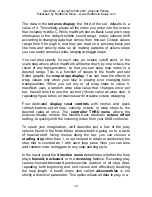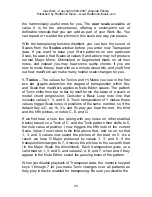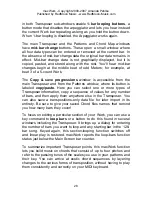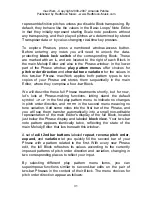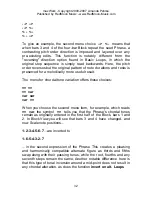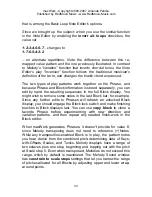
maxWerk - Copyright 2000-2007 Amanda Pehlke
Published by RedMoon Music - www.RedMoon-Music.com
24
graphically displayed Transposer values, to arrive at the chord
information in the Leadsheet and the chord names you see
displayed on the Main Screen. Unlike other Transposer elements
that can be disabled, Global Offsets are always in effect.
To make the clearest explanation, we'll describe the displayed data
types starting with the bottom-most of the four in the Transposer
window. We'll move upward, and then mix them up. They are:
4. Key - Transposing Keys cover the twelve semitones of the
western octave. Values 0 through 11 set the Tonic pitch for the
musical Scale in use. These pitches, summed with Global Offsets,
partly determine the chord names shown on the Main Screen. Their
combined I-chord result tells the "key signature" as in conventionally
notated music, with the difference that in maxWerk each bar is
tagged with its own Transposing Key number and Global Offset.
You may wish to change Key only once or twice during your song
for emotional effect, or you may wish to let maxWerk change Key
values automatically many times to accommodate complex chord
progressions. You may elect not to use changing Transposing Key
information at all, if you are feeling entirely modal in your approach
to your Werk. Of course, doing experiments with one data set will
not harm any of the others.
3. Scale - Scale values determine the selection for each bar of
seven pitches out of twelve that are represented by the note values
entered in maxWerk. These values take effect after Key data, but
before any further transposing you do in the remaining two displays.
Scales, also called modes, have values 0 through 11 in the display.
They include the seven traditional ones at 1 through 7, with the
familiar names Natural-Minor, Locrian, Major (the default scale),
Dorian, Phrygian, Lydian, and Mixolydian. The Harmonic-Minor and
Blues scales are given values 7 and 8, and the Suspended,
Diminished, and Augmented scales, often used for special-purpose
chord changes, have values 9 through 11.
In case you hadn't thought about it before, differences between
scales have to do with the patterns of whole and half-step intervals
found between the notes of each set, and maxWerk has memorized









